BP Portrait Award 2018: Exclusive Artist Interviews Part 1
Posted by Cass Art on 2nd Aug 2018
The BP Portrait Award is back for its thirty-ninth year at the National Portrait Gallery. The prestigious painting competition brings us the very best in contemporary portraiture today; showcasing a breadth of approaches to portraiture this year’s award includes the unusual, the beautiful and the uncanny. The top prize of £35,000 was awarded to Miriam Escofet for her ethereal portrait of her mother: An Angel at My Table, with Ania Hobson winning the Young Artist Award for her painting A portrait of two female painters.
This years exhibition has ranged from self-portraits, to portraits of friends, family and strangers - with the occasional famous face too! This year’s group of artists truly express the breadth and diversity of contemporary portraiture, from detailed hyperrealism to bold blocks of colour. They push the boundaries of figurative painting and show us that portraiture is still very much present in painterly conversation. Portraiture and figurative painting is as relevant and exciting today as it has been for hundreds of years.
We caught up with some of the shortlisted artists of 2018 for an insight into their process, their must-have materials to achieve their unique approaches to painting and the inspiration behind their works:
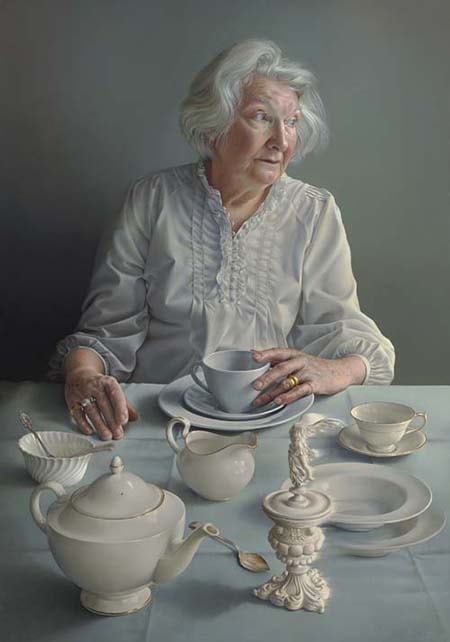
Miriam Escofet, An Angel At My Table (on show at this years BP Portrait Award)
Miriam Escofet
Miriam undertook a BA (Hons) degree in 3D design at Brighton School of Art. She has exhibited across Europe and her work is regularly selected for the annual exhibitions of the Royal Society of Portrait Painters. She was previously selected for the BP Portrait Award in 2007, 2009, 2010 and 2012 - this year she was selected for the 1st prize.
Congratulations on winning the 1st prize at this year’s BP portrait award. Before we begin discussing your paintings and process, how do you find the experience of the portrait award, having exhibited in the past and now being awarded the 1st prize?
Over the years the BP Portrait Award has become one of the major international art competitions. Exhibiting in it is really fantastic exposure for any artist, regardless of whether one is shortlisted for the prizes, just being included in the exhibition is wonderful. I have exhibited in the BP show four times previously, people remember seeing your work and I have had commissions through it. When I was told that I had been shortlisted for the prize I was absolutely over the moon and winning the first prize felt like one of those rare moments in life when all the stars align. The only downside to it is not being able to enter the competition again.
There is an ethereal and otherworldly quality to your prize winning work; the off whites of your colour palette in the porcelain, tablecloth, her clothing and hair, the objects are almost uncanny in their emptiness. These notions are also implied in the title An Angel at My Table. What was your thought process when making these choices in this work?
I have tried to suggest a sense of space, perspective and time. My mother has a wonderful inner stillness and calm, and I really wanted to convey these qualities in the work. I was also conscious whilst painting her that I wanted to transmit an idea of the Universal Mother, who is at the centre of our psyche and emotional world and the composition of the painting aims to underpin that idea. By placing her at the centre of the pictorial space and deliberately unifying the perspective of the objects to lead to a vanishing point contained within her. So the work is both personal and symbolic.
The title for the work can be interpreted in many ways, all of which express an aspect of the painting. The ‘angel’ could literally be the winged figure on the table, or my mother, or some protective force around her, or of course all three. It struck me as being poetic and having an ambiguous open meaning. I knew from the start that I wanted the painting to be fairly monochromatic and to be a play of light and whites, with the only note of colour coming from my mother’s skin. Leaving the cups and vessels empty was also a way of keeping the feeling of the work allegorical and ethereal.
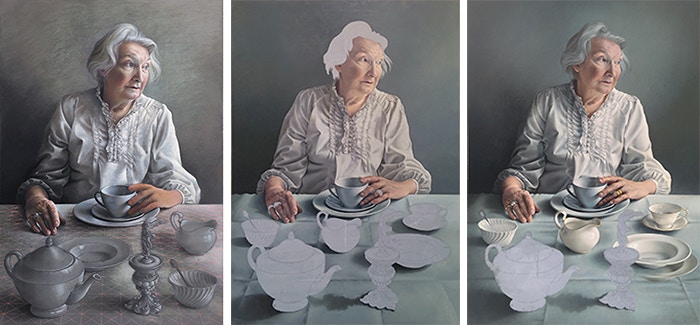
Miriam Escofet, Stages of An Angel at My Table
There is a great deal of labour behind your practice, what the viewer might not know is the work you perform even before undertaking the painting they are standing in front of. Could you take us through this process and the materials you use in these iterations? - From casting your own objects, to rendering near perfect versions in both pastels and charcoal.
I always work from a very detailed drawing and this can be realised in many different ways and media. I also spend a lot of time thinking about composition and I like to explore various ideas for layouts at the drawing stage.
For my portrait ‘An Angel At My Table’ the initial stage was a drawing from life that developed into a very detailed pastel study, which took about 3 weeks, some of this time was also spent working out the perspective of the objects in the composition in separate line studies. The pastel study was scaled up for the oil painting, but I then developed the idea for the layout of the objects further and again this was resolved with more perspective studies. I love perspective! I often construct models, props or maquettes that become subject matter for my paintings. For the portrait of my mother I cast the ‘Angel Cup’ out of plaster and it is actually a composite of various objects that I have. This became the ‘magical’ element in the painting, which opened up the idea for introducing a sense of movement in some of the objects.
See more of Miriam's work on her website
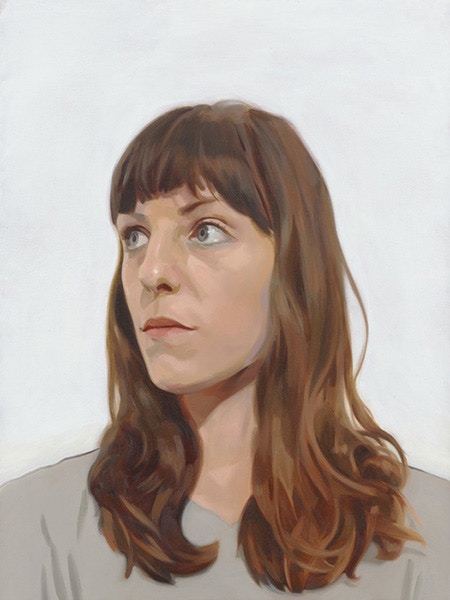
Liesel Thomas, Self Portrait (on show at this years BP Portrait Award)
Liesel Thomas
Liesel undertook foundation studies at West Kent College, Tonbridge, followed by a BA (Hons) degree in fine art-painting at Slade School of Fine Art, London. She has exhibited in London, Edinburgh and Berlin, and has undertaken a residency at Takt Gallery, Berlin.
Your painting in the BP portrait award was an “exercise in adding creative brushwork” – was it difficult to break away from your usual approach to painting? Did you also change your materials to marry in with this new style; a different brush perhaps, or new type of paint?
I'd been painting in a hyperreal style for some time which, whilst I enjoy the style, it's quite time consuming to produce. So I wanted to break away from that to allow myself to work through ideas more quickly. It wasn't difficult as I used to paint this way, I was just a bit out of practice so it was more an exercise in scaling up, and allowing the brush strokes to become a focus of the painting again. The materials didn't really change - except the size of the brushes! I prefer synthetic filbert brushes like Monarch by Winsor & Newton, and I currently use a mixture of Michael Harding, Winsor & Newton, Old Holland and Mussini oils. However I'm trying to phase out oils that contain animal products as I'm vegan. Firstly I block in facets of colour, then I blend areas to reduce the appearance of brush marks, which gives the painting a softness. The various subtle changes in tone and colour help to model the face.
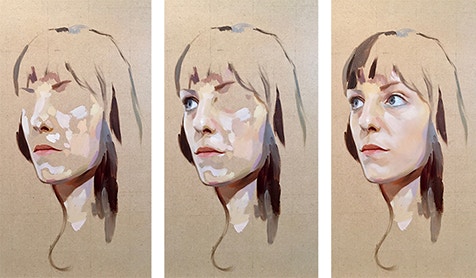
Liesel Thomas, Work in progress Self-portrait
You also mention wanting your portrait to be honest, a very challenging undertaking when completing a self-portrait! How did you find studying yourself after so many years of painting others?
Working on commissions you obviously have a brief to work to, but this was different and very straightforward, I didn't intend to show the painting so that allowed a certain amount of freedom. I suppose I wanted it to be unfussy, which is what I mean by an 'honest' piece of painting - painting for painting's sake. I wasn't interested in painting every wrinkle and pore, I wanted to capture an overall likeness. It was all about the process, moving away from detail, and what I ended up with was a very honest and simple portrait of an artist thinking about their painting practice. The white background is a subtle suggestion of the white walls of a gallery or studio space. Maybe I'll paint another self portrait in twenty years, but in the meantime I enjoy the challenge of painting others.
See more of Liesel's work on her website and follow her on Instagram to keep up with her creative endeavours
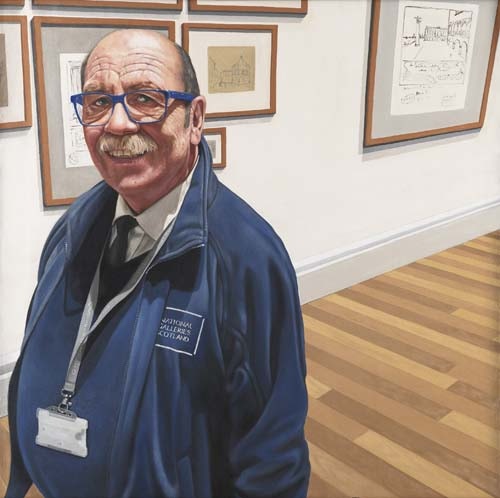
Laura Nardo, LTR team A (on show at this years BP Portrait Award)
Laura Nardo
Laura gained a degree in fine arts at the Accademia di Belle Arti di Venezia, painting and drawing section and has exhibited in Venice and Udine.
You gained your degree in Fine Art at the Accademia di Belle Arti di Venezia, how do you think studying there has influenced your work - given Venice’s rich cultural history, and modern impact of the biennale?
Venice boasts such an enormous art heritage that it is impossible not to be influenced by its history. I had the fortune to practice painting in the prestigious rooms of the Accademia di Belle Arti that has hosted many masters of the past. The Accademia di Belle Arti was connected to the Gallerie dell'Accademia that displays Giovanni Bellini, Vittore Carpaccio, Giorgione, Pietro Longhi... the list is endless. Beholding and studying the artwork of such big Italian masters just two steps out of my classroom, and also visiting the Biennale di Venezia which is still one of the most important centres for the contemporary Art, has allowed me to develop my sensitivity and my passion for Art.
You’ve managed to capture the character of Vittorio brilliantly! The friendly faces of staff are the foundations of our museums and galleries, and are vital in keeping the Art Institution going. It must be interesting to perform on both sides of the curtain, working in the Scottish National Gallery of Modern Art yourself?
Venice yesterday and Edinburgh today. Working at the NGS I still have the privilege and the fortune to be surrounded by extraordinary artworks once again.The idea to work and see the 'cultural machine' behind the scene is another privilege; every day I can spend extra time perusing a particular painting or artwork that caught my attention. Sometimes it becomes an interesting topic to compare with my colleagues, most of us are artists and that is one of those situations where brain storming happens! I was inspired by Vittorio's figure in an ordinary working day, I thought that it would be interesting to paint a portrait of a man who boasts a long experience in a such stimulating environment that is a source of inspiration as well.
See more of Laura's work on her website
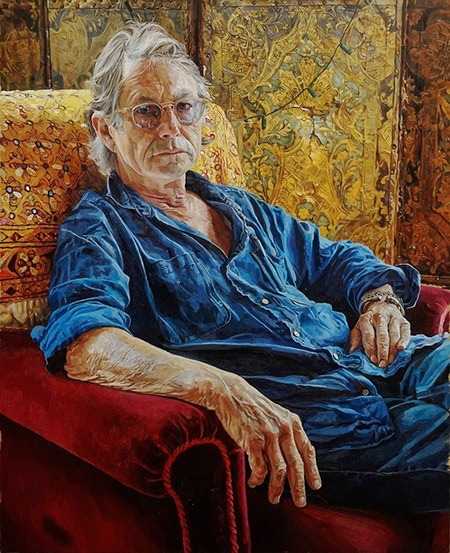
Alastair Adams, Bruce Robinson, Writer and Director (on show at this years BP Portrait Award)
Alastair Adams
Alastair has studied at Hugh Baird College, Bootle and Leicester Polytechnic. His work is held in numerous collections and has been exhibited in the exhibitions of the Royal Society of Portrait Painters and the Manchester Academy Annual Open Exhibition. He has previously been selected for the BP Portrait Award in 1995.
You bring a great sense of context through the environments of your portraits. Your sitters are enveloped in patterned wallpaper, lean on desks in their offices, sit pensively in their homes, or bask in the sunlight of a London skyline. Could to talk about the relationship between the setting and the subject in your paintings?
I’m interested in making very subject specific portraits that offer an insight in to their life and roles, where appropriate, within society. In order to do this I will try to align appropriate ‘signifiers’ to appear naturally in my compositions where the light is good for me to paint. I like the viewer to find out about the person by reading my portraits perhaps more than just focusing on the paint handling and empathising with emotive facial expression, though those are part of the mix too! This is a pretty established way of representing someone but usually my subjects haven’t been painted before so that’s OK by me. I try and avoid traditional settings where possible and, where I can, empower my subjects with light, colour and painting language rather than gender specific or academically sublime poses.
What are the vital tools in your studio and how to they influence your process?
I work both with digital and analogue technology bringing processes together to suit the way I like to represent people. I’m happy to use a digital camera to work out compositions and capture time consuming detail so that these can be reflected and worked on back in the studio. Everything comes from a commitment to a relationship though so I use sittings to paint and talk to my subjects.
Materials wise I use Winsor & Newton Oil Paint, on board, and paint with Rosemary Ivory and Pro Arte brushes. I seal the board with Spectrum clear acrylic canvas sealer before I get going and use a Best Santa Fe II easel. I use a limited palette of colours, mixing complementaries to create vibrant warm colours and clean cool shadowed colours. I prefer purple to brown in the shadows!
See more of Alastair's work on his website
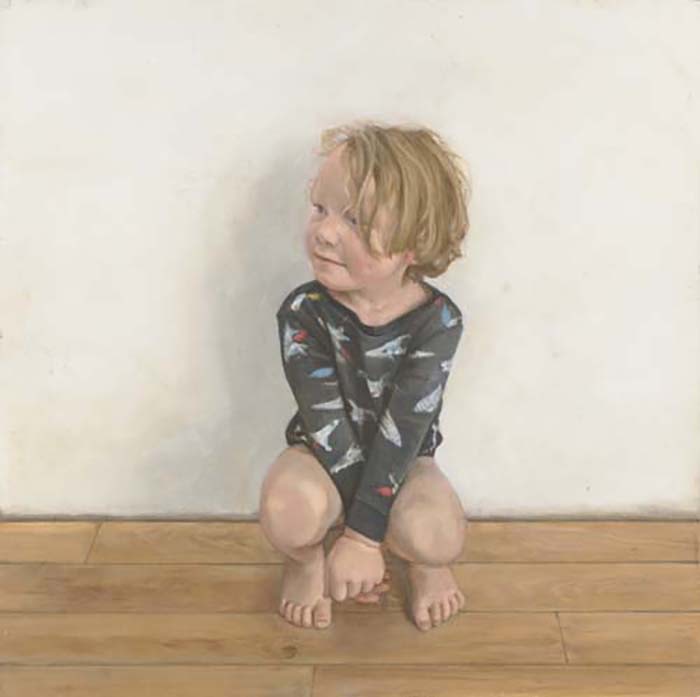
Samantha Fellows, Found Albert crouching in the kitchen (on show at this years BP Portrait Award)
Samantha Fellows
Samantha undertook a Bachelor of Fine Arts degree at Oregon State University. She has exhibited in the Lynn Painter-Stainers Prize, the Royal Academy of Arts Summer Exhibition and has been selected for the BP Portrait Award in 2016.
Your portrait in the BP portrait award is of your nephew Albert taking a stand after not wanting to pose for a formal portrait with his brother. Are your family members often the subjects of your paintings, and how do you think painting them enriches your relationships with them?
Yes, I’m always sketching and painting family members. I’m forever desperately trying to be disciplined and draw every day, to improve technique and keep ideas flowing, and so am often inspired to draw my family around me - I also think that’s the least they can do for me, keep still for a minute while I draw them! And then ideas for paintings usually come from these initial sketches. As the artist of the extended family, I did want to capture my nephews Albert and Vincent in a painting at this time of their lives, for my sister.
I do think there’s something special that happens when painting faces (and genes!) you know so extremely well. Something instinctive seems to take over as you try to capture their likeness and character - it’s very exciting when this happens and also makes the whole process a lot easier than when painting commissions of people you hardly know and have only just met.
What are the vital tools in your studio?
I’m struggling hugely with my studio right now. It’s in my home which I love, but is so small and so cramped with all the paints and materials I also need for my work as a freelance scenic artist, I need to consider relocating. Having a studio at home is fantastic for squeezing in studio time. I’m particularly fond of sneaking out of bed and into my studio at around 5am and so a lamp with a daylight bulb is probably my most vital tool for keeping things moving along in the studio. I’ve also recently inherited items from my godfather’s studio, and have started to become quite passionate about using and collecting vintage pencils - I’m convinced they’ve improved my drawing!
See more of Samantha's work on her website
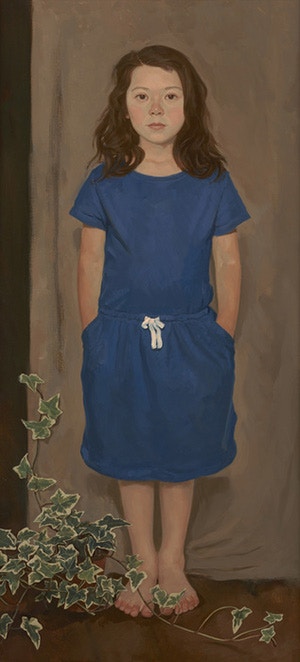
Neale Worley, Ilea (on show at this years BP Portrait Award)
Neale Worley
Neale studied at Camberwell College of Art and the Royal Academy Schools. He has exhibited in the Lynn Painter-Stainers Prize, Discerning Eye, the Royal Society of Portrait Artists and the Royal Academy of Arts. He was previously selected for the BP Portrait Award in 1992 and 1993.
Across your paintings your tonal range has a great depth and richness. Could you talk us through your palette, and how you acheive this with your mixing?
I use a basic palette. white , Yellow ochre, Raw sienna, Lemon Yellow, Raw umber, Burnt umber, Ultramarine blue, Cadmium red, Alizarin crimson, Viridian green, Ivory black. I tend to pre-mix colours with a palette knife. Once paint is applied re-adjustments can be made. It’s not until something is down on the canvas that you can make value judgements. The composition of the painting tends to be sketched out in thin paint first.
Your choice of composition in the painting of your daughter Ilea is interesting in that it is a full front profile – her innocence implied in her open expression, simple clothing and shoe-less. What was your thought process with the composition?
My thought process regarding the BP portrait of my daughter was simplicity for most and confrontation with the viewer.
See more of Neale's work on his website
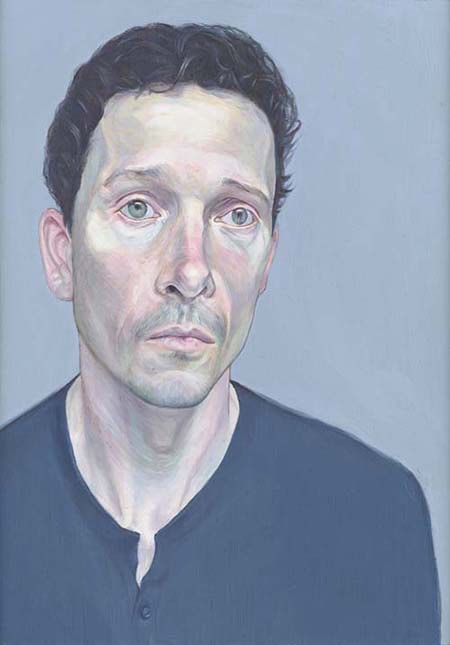
Peter James Field, Robert (on show at this years BP Portrait Award)
Peter James Field
Peter undertook a BA (Hons) degree in the history of art and architecture at UEA Norwich and a BA (Hons) degree in illustration at the University of Brighton. His work has been included in publications including Vanity Fair, The Times and Time Out magazine. He has exhibited in London, Brighton and Edinburgh.
You’ve managed to capture a great sense of melancholy and sadness in your portrait of Robert. Is it hard to convey very specific emotions through portraiture and what techniques are at your disposal to guide the viewer in this way?
I was guided by the sitter – looking closely at him, I tried to faithfully represent the truth of what I felt I was seeing. To me it’s about getting into a calm meditative state in which it is (sometimes) possible to connect emotionally with the sitter. Personally I think if you sit down and say ‘let’s paint a melancholy portrait’, then it will come out feeling somehow contrived. I always listen to music when I work; I try and choose emotional songs that will make me feel something deeper than language. I never talk as I work – I try to switch off all interior monologue and just feel what I’m seeing. I trust that the emotions will come through if I can get into that state.
Drawing is massively important to me. I try to get a drawing that expresses something a little more than could be captured with just a photo. I can draw a subject seven or eight times till I get that elusive thing I’m searching for. The emotion has to be there in the drawing before I will commit to paint.
Your palette contains a mixture of greens, blues and yellows, could you talk us through your use of colour in your work?
This portrait marked the beginning of an ongoing experiment in limiting my colour options. I worked with Ultramarine, Lemon Yellow, Crimson and White – strictly only these four colours, and no black. I mostly use a fast drying (alkyd) Titanium white. It's the only alkyd I use, I tend to mix white with almost every other colour I use - so it speeds up the average drying time on almost everything. I am impatient! I wanted to focus on colour mixing from primaries only, as I have suffered in the past from an over-reliance on ready-made earth colours. Also, having too much stuff squeezed out on your palette can make you lazy and, worse, confused. I think the greens and blues in the skin were a result of this colour experiment.
I allowed the sitting and the emotions to dictate the colour palette overall – there was no plan as such, but certain decisions seemed to make themselves. For example, Robert wasn’t sitting against blue, but after a few experiments I realised this needed to be the background colour.
See more of Peter's work on his website
Feeling Inspired?
Want to try your hand at your own portrait? We've got everything you need - from paints, brushes and canvas. Take a look online or pop in-store to talk to our staff artists who'd be happy to help with any questions you have about getting started. Don't forget to hashtag #cassart on social media to show us your creative endevours!
Our annual exhibition Face to Face at Cass Art Islington brings together the works of artists exhibiting in the BP Portrait Award 2018 at the National Portrait Gallery. An insight into their practice beyond the award, this show celebrates portraiture and figurative painting in its many forms.
Face to Face is opening on the 14th of August and runs until the 9th of September. Join us for the Private View on Thursday the 16th of August: Find out more
Lead Image: Miriam Escofet Kathryn and Milo


